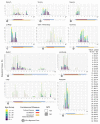SARS-CoV-2 Molecular Transmission Clusters and Containment Measures in Ten European Regions during the First Pandemic Wave
- PMID: 33803490
- PMCID: PMC8001481
- DOI: 10.3390/life11030219
SARS-CoV-2 Molecular Transmission Clusters and Containment Measures in Ten European Regions during the First Pandemic Wave
Abstract
Background: The spatiotemporal profiling of molecular transmission clusters (MTCs) using viral genomic data can effectively identify transmission networks in order to inform public health actions targeting SARS-CoV-2 spread.
Methods: We used whole genome SARS-CoV-2 sequences derived from ten European regions belonging to eight countries to perform phylogenetic and phylodynamic analysis. We developed dedicated bioinformatics pipelines to identify regional MTCs and to assess demographic factors potentially associated with their formation.
Results: The total number and the scale of MTCs varied from small household clusters identified in all regions, to a super-spreading event found in Uusimaa-FI. Specific age groups were more likely to belong to MTCs in different regions. The clustered sequences referring to the age groups 50-100 years old (y.o.) were increased in all regions two weeks after the establishment of the lockdown, while those referring to the age group 0-19 y.o. decreased only in those regions where schools' closure was combined with a lockdown.
Conclusions: The spatiotemporal profiling of the SARS-CoV-2 MTCs can be a useful tool to monitor the effectiveness of the interventions and to reveal cryptic transmissions that have not been identified through contact tracing.
Keywords: COVID-19; SARS-CoV-2; clusters; molecular epidemiology; molecular transmission clusters; pandemic; phylodynamics; phylogenetics; transmission.
Conflict of interest statement
The authors declare no conflict of interest.
Figures



Similar articles
-
Tracing the First Days of the SARS-CoV-2 Pandemic in Greece and the Role of the First Imported Group of Travelers.Microbiol Spectr. 2022 Dec 21;10(6):e0213422. doi: 10.1128/spectrum.02134-22. Epub 2022 Nov 21. Microbiol Spectr. 2022. PMID: 36409093 Free PMC article.
-
A Founder Effect Led Early SARS-CoV-2 Transmission in Spain.J Virol. 2021 Jan 13;95(3):e01583-20. doi: 10.1128/JVI.01583-20. Print 2021 Jan 13. J Virol. 2021. PMID: 33127745 Free PMC article.
-
Detection of SARS-CoV-2 infection clusters: The useful combination of spatiotemporal clustering and genomic analyses.Front Public Health. 2022 Dec 1;10:1016169. doi: 10.3389/fpubh.2022.1016169. eCollection 2022. Front Public Health. 2022. PMID: 36568782 Free PMC article.
-
Molecular Epidemiology Analysis of SARS-CoV-2 Strains Circulating in Romania during the First Months of the Pandemic.Life (Basel). 2020 Aug 14;10(8):152. doi: 10.3390/life10080152. Life (Basel). 2020. PMID: 32823907 Free PMC article.
-
Surveillance Metrics of SARS-CoV-2 Transmission in Central Asia: Longitudinal Trend Analysis.J Med Internet Res. 2021 Feb 3;23(2):e25799. doi: 10.2196/25799. J Med Internet Res. 2021. PMID: 33475513 Free PMC article.
Cited by
-
Reconstruction of Viral Variants via Monte Carlo Clustering.J Comput Biol. 2023 Sep;30(9):1009-1018. doi: 10.1089/cmb.2023.0154. Epub 2023 Sep 11. J Comput Biol. 2023. PMID: 37695837 Free PMC article.
-
Biological and Clinical Significance of Adaptive Evolution of Coronaviruses.Life (Basel). 2021 Oct 23;11(11):1129. doi: 10.3390/life11111129. Life (Basel). 2021. PMID: 34833006 Free PMC article.
-
Role of genomics in combating COVID-19 pandemic.Gene. 2022 May 20;823:146387. doi: 10.1016/j.gene.2022.146387. Epub 2022 Mar 4. Gene. 2022. PMID: 35248659 Free PMC article. Review.
-
Molecular and Clinical Prognostic Biomarkers of COVID-19 Severity and Persistence.Pathogens. 2022 Mar 2;11(3):311. doi: 10.3390/pathogens11030311. Pathogens. 2022. PMID: 35335635 Free PMC article. Review.
-
Tracing the First Days of the SARS-CoV-2 Pandemic in Greece and the Role of the First Imported Group of Travelers.Microbiol Spectr. 2022 Dec 21;10(6):e0213422. doi: 10.1128/spectrum.02134-22. Epub 2022 Nov 21. Microbiol Spectr. 2022. PMID: 36409093 Free PMC article.
References
-
- Zhou H., Chen X., Hu T., Li J., Song H., Liu Y., Wang P., Liu D., Yang J., Holmes E.C., et al. A novel bat coronavirus closely related to SARS-CoV-2 contains natural insertions at the S1/S2 cleavage site of the spike protein. Curr. Biol. 2020;30:2196–2203. doi: 10.1016/j.cub.2020.05.023. - DOI - PMC - PubMed
LinkOut - more resources
Full Text Sources
Other Literature Sources
Miscellaneous

